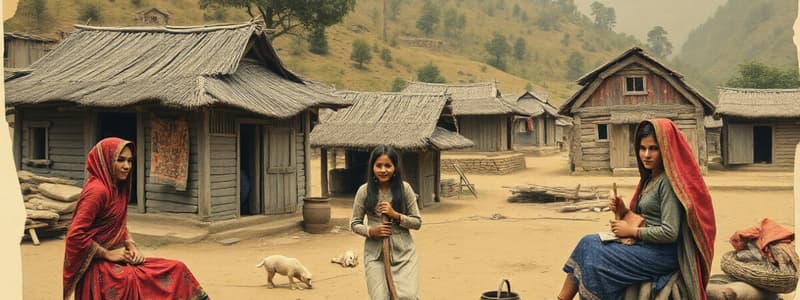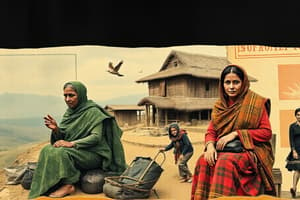Podcast
Questions and Answers
How does the author implicitly critique the traditional game of 'Wedding' played by the girls?
How does the author implicitly critique the traditional game of 'Wedding' played by the girls?
- By highlighting the girls' lack of genuine understanding of marital responsibilities.
- By contrasting the playful depiction of marriage with the harsh realities faced by women in the mountains. (correct)
- By emphasizing the economic burden placed on families when arranging marriages for their daughters.
- By suggesting that the game perpetuates gender stereotypes and limits girls' aspirations.
What does the lack of modern facilities in Shangla implicitly suggest about the region's socio-economic status and its relationship with broader societal development?
What does the lack of modern facilities in Shangla implicitly suggest about the region's socio-economic status and its relationship with broader societal development?
- It demonstrates the region's resilience in maintaining its unique cultural identity despite external influences.
- It implies that the community is content with its simple lifestyle and has no desire for modern amenities.
- It indicates a self-sufficient community that prioritizes traditional values over modernization.
- It highlights the region's isolation and marginalization from mainstream development and essential services. (correct)
Considering the cultural context, what is the most likely reason the author’s cousins tease her for wearing bazaar-bought clothes instead of homemade ones?
Considering the cultural context, what is the most likely reason the author’s cousins tease her for wearing bazaar-bought clothes instead of homemade ones?
- They envy her access to modern goods and are expressing their resentment.
- They perceive her clothing as a rejection of their traditional way of life and values. (correct)
- They are trying to assert their dominance and make her feel out of place in their community.
- They are genuinely curious about her fashion choices and want to learn more about city styles.
How does contrasting the author's 'city girl' identity with her experience in the village exposes the complexities of cultural identity and social perception?
How does contrasting the author's 'city girl' identity with her experience in the village exposes the complexities of cultural identity and social perception?
How does the description of the feast at Small Eid contrast with the earlier depiction of poverty in Shangla, and what does it imply about the community's values and priorities?
How does the description of the feast at Small Eid contrast with the earlier depiction of poverty in Shangla, and what does it imply about the community's values and priorities?
What is the most likely reason that the author emphasizes her mother's illiteracy as an 'unspoken sadness'?
What is the most likely reason that the author emphasizes her mother's illiteracy as an 'unspoken sadness'?
Given the broader context of gender inequality, what does the statement 'Why send a daughter to school?' primarily reveal about societal attitudes?
Given the broader context of gender inequality, what does the statement 'Why send a daughter to school?' primarily reveal about societal attitudes?
How does the description of the Flying Coach climbing higher and higher, until only mountains and a 'sliver of sky' are visible, symbolically represent the challenges and constraints faced by the people in Shangla?
How does the description of the Flying Coach climbing higher and higher, until only mountains and a 'sliver of sky' are visible, symbolically represent the challenges and constraints faced by the people in Shangla?
Considering the sociopolitical climate, what does the act of women having to hide their faces suggest about the power dynamics and social control within the community?
Considering the sociopolitical climate, what does the act of women having to hide their faces suggest about the power dynamics and social control within the community?
What underlying message is conveyed by the detail that men often leave the villages to work in distant and dangerous locations?
What underlying message is conveyed by the detail that men often leave the villages to work in distant and dangerous locations?
Flashcards
Gender roles in the village
Gender roles in the village
In the village, traditional gender roles restrict women from education and social freedom.
Illiteracy among women
Illiteracy among women
Many women, including Malala's mother, could not read, reflecting a broader societal issue.
Childhood games
Childhood games
Girls played a game called 'Wedding,' mimicking traditional ceremonies with pretend rituals.
Living conditions
Living conditions
Signup and view all the flashcards
Cultural feast
Cultural feast
Signup and view all the flashcards
Separation of genders
Separation of genders
Signup and view all the flashcards
Perceptions of daughters
Perceptions of daughters
Signup and view all the flashcards
Sophisticated city girl
Sophisticated city girl
Signup and view all the flashcards
Lack of recreational materials
Lack of recreational materials
Signup and view all the flashcards
Cultural constraints on education
Cultural constraints on education
Signup and view all the flashcards
Study Notes
Shangla Village Life
- The author lived a simple life in a village in Shangla
- The village was poor, lacking modern facilities like hospitals, markets, clean water, and electricity
- Families were very poor, but celebrated festivals like Small Eid with large feasts
- The author's family had modern facilities but this was unusual
Gender Roles
- Boys fished in the afternoon
- Girls played a wedding game called "Wedding"
- Women hid their faces when leaving homes
- Many women could not read, which was common
- Girls often did not go to school.
Studying That Suits You
Use AI to generate personalized quizzes and flashcards to suit your learning preferences.



